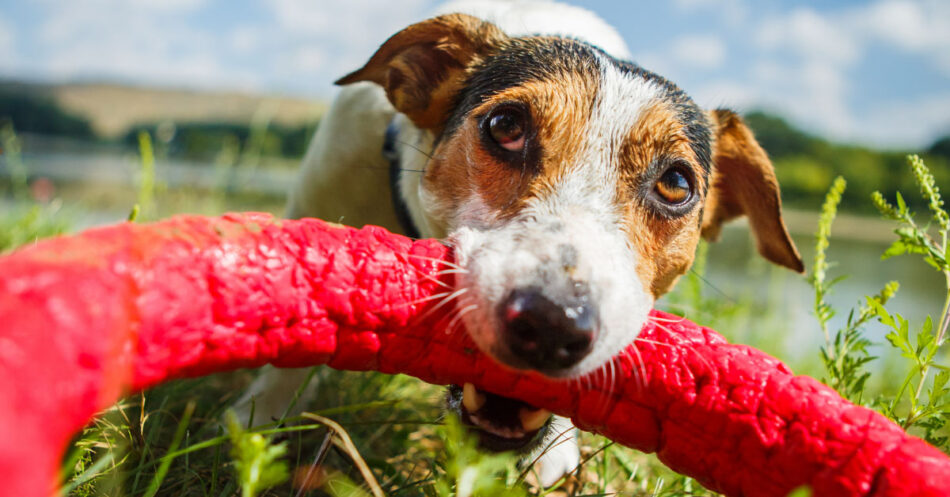
How to Wash Dog Toys So They’re Actually Clean
This post may include affiliate links. Please read my disclosure policy.
Wash dog toys regularly to prevent bacteria growth. Dog toys should be washed every 2–4 weeks or more, often depending on how much your dog plays with them. Plush dog toys can typically be washed in the washing machine with a bio-enzymatic cleaner, like Kinderbean’s™ No Stress Mess Eraser. Other toys may be hand-washed or put in the dishwasher, per the manufacturer’s instructions.
Read time: 4 1/2 minutes
Like you, I’ve picked up my fair share of slobbery and dirty dog toys from the living room floor, not to mention balls and outdoor toys we bring to the park. My dog’s favorite toys can get quite smelly and ragged!
It’s so important to clean dog toys and keep them in good shape. Not just because they look and feel gross otherwise, but because it impacts our dogs’ safety and health.
Why It’s Important to Keep Your Dog’s Toys Clean
Not all dog toys are indestructible. As your dog gnaws on their favorite plushy, ball, or puzzle, it becomes worn and may eventually become a hazard to your dog’s digestive system. Depending on the quality of the toy, this can happen within minutes, or sometimes months.
Regularly cleaning dog toys gives you an opportunity to physically inspect frayed fabric or rope, loose parts, or torn-out squeakers. If you can make repairs, great. But if you can’t, it’s time to toss it!
The second reason I advocate for regular toy washing is that, according to the National Safety Federation (NSF), pet toys are among the top 10 germ-filled spots in our homes. They are known to contain coliform bacteria (including staph bacteria), yeast, and mold. It’s not only dangerous for your pet to be ingesting those toxic forms of bacteria, but it’s unsafe for you and your family to handle. So let’s talk about how to wash dog toys properly so they’re actually clean!
Pin Me!
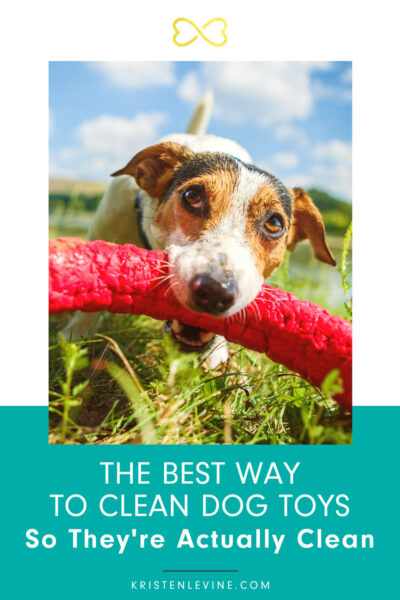
How to Clean Plush Toys, and Rope Dog Toys
First, go through your inspection process and make sure your dog’s stuffed toys or squeaky toys don’t need to be repaired or tossed. If all is well except for some matted nasty fur, go ahead and put them in a mesh bag and toss them in the washing machine.
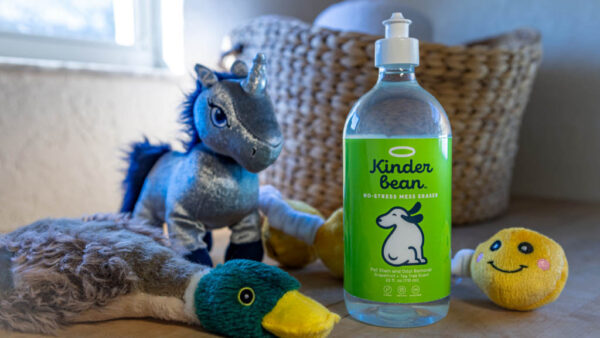
I recommend using a bio-enzymatic cleaner like Kinderbean’s No Stress Mess Eraser to get your dog’s toys clean without using harsh or toxic chemicals or perfumes. It has a gentle citrus scent from essential oils that are not toxic to dogs.
An enzyme cleaner works best because it actually eats the bacteria left on the toy from your dog’s mouth. It’s a natural way to remove any organic matter on your dog’s toys, like saliva, which can contain bacteria that will cause soft dog toys to really stink and, in rare cases, can cause illness in humans!
For up to three plush dog toys, simply add one cup of No Stress Mess Eraser to your laundry detergent dispenser and wash as usual with warm water. If dirt is deeply embedded in the stuffed toys, you may need to soak them in No Stress Mess Eraser and then wash with a mild or pet-safe laundry detergent, such as Woolite. Once the wash cycle is done, you can either squeeze out any extra water from your pet’s toys and air dry them or throw them in the dryer on low.
Lastly, be sure to make one final inspection before throwing them back in your dog’s toy bin. Ensure the laundering process didn’t loosen any parts that might be swallowed by your dog.
How to Clean Plastic, Rubber, and Nylon Dog Toys
If the manufacturer’s directions say you can put your plastic, nylon, or rubber dog toys in the dishwasher, go ahead and do so, but wash your dog’s toys separately from other household items. I don’t advise cleaning pet toys with regular dishwasher detergent as this is very caustic and toxic to dogs. Yes, it’s true we eat off dishes cleaned with dishwasher detergent, but our dogs are only with us for a bit more than a decade, so I prefer not to take any chances when it comes to toxic substances!
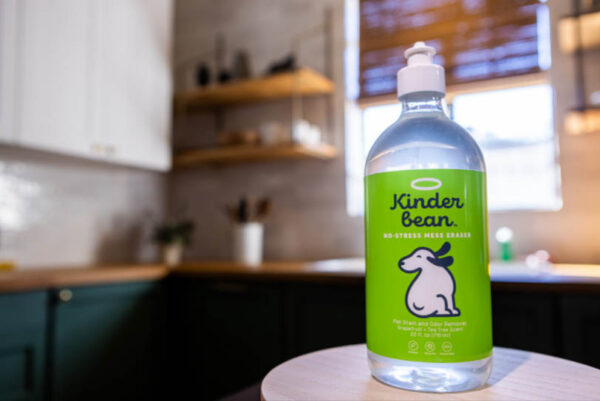
To clean your dog’s toys, first, soak them in Kinderbean’s No Stress Mess Eraser. Fill your sink with warm water, add one cup of Mess Eraser, and let the toys soak in the solution for up to an hour. This step is especially important for toys that hold sticky peanut butter or treats, like a Kong toy. Put the toy in the dishwasher and run with it without detergent.
If your dog’s plastic chew toys can’t go in the dishwasher, simply fill a sink or plastic tub with warm water and add 1 cup per half-gallon of water of No Stress Mess Eraser to the water. Let the toys soak for at least one hour and then gently scrub them with a vegetable brush. Rinse them thoroughly and inspect for any wear and tear that might be dangerous to your pup.
Plastic toys can develop hard edges that can cut your dog’s gums, and they may also deteriorate, causing chunks of plastic or rubber to tear off (check this post out for my list of recommended indestructible dog toys). If you see any of these tell-tale signs of wear, toss the toy and replace it with a new one!
How Often Should I Wash Dog Toys
Clean dog toys at least every two weeks, sometimes more frequently if your dog is particularly slobbery. Other toys your dog doesn’t favor as much may be able to last four weeks without a wash.
It’s easy to forget to do, so consider adding a reminder to your calendar or even your Alexa device.
How to Clean Dog Toys That Came Into Contact With Parvovirus
When it comes to something as serious as parvovirus, caution is key. We, as pet parents, absolutely should not take any chances.
First, wear disposable gloves when you handle the toys that have been exposed to parvovirus. Minimize all possible risks for our furry friends.
Gather all toys that might have been exposed to the virus, even if the likelihood of exposure seems minimal. These include toys that other dogs outside your home have played with, especially if those dogs show signs of parvo, or the toys have been to places like kennels, shelters, or veterinarian clinics. Dispose of any toys that are porous, like plush or rope toys. These cannot be effectively disinfected against parvovirus and should be tossed in a sealed plastic bag for disposal.
Cleaning dog toys made of rubber, nylon, or plastic requires a bleach solution. According to ASPCA, cleaning your dog’s toys with a properly diluted bleach solution and rinsing them well is safe. Allow the toys to soak in this solution for at least 10–15 minutes. If you absolutely don’t want to use bleach, there are some disinfectants that can work as alternatives.
After soaking, rinse the toys in warm water thoroughly to remove any bleach residue. I can’t stress enough the importance of rinsing well; bleach is harmful if ingested. Once rinsed, you can opt to soak the toys for a second round in Kinderbean’s No Stress Mess Eraser, as directed in the previous section, for added peace of mind.
Because the bleach solution can be hard on plastic or rubber toys, closely inspect each toy for any signs of degradation, like cracking or softening of the material. If you see any of these red flags or if the toy already had some wear and tear, now’s the time to say goodbye to that toy. Toss it out and invest in a new, safe option for your beloved pooch.
Parvovirus, often called “parvo,” is a very contagious virus that affects dogs, especially unvaccinated ones and puppies under four months. It hits the stomach and spreads when dogs come in contact with infected dogs, their poop, or things they’ve touched. The virus can survive on surfaces for months in various conditions and can be carried from one place to another on shoes, dog fur, or toys.
Remember, the safety and health of our dogs are top priorities. While discarding your dog’s squeaky toys, especially their favorites, may seem heartless, it’s a necessary step for their well-being. Safety first, sentiment second!
The Tail End
Washing your dog’s toys regularly is important for their health and well-being and even your own! Avoid using harsh chemicals, and instead, use an enzymatic cleaner to combat the bacteria that is inevitably growing on your dog’s toys. Always inspect your dog’s toys for damage before returning them back to the toy bin.
Playing with your dog is one of the best ways to bond. Playtime allows you to connect and destress together. Looking for more ways to bond with your dog? Download my free ebook, How to Bond with Your Dog.
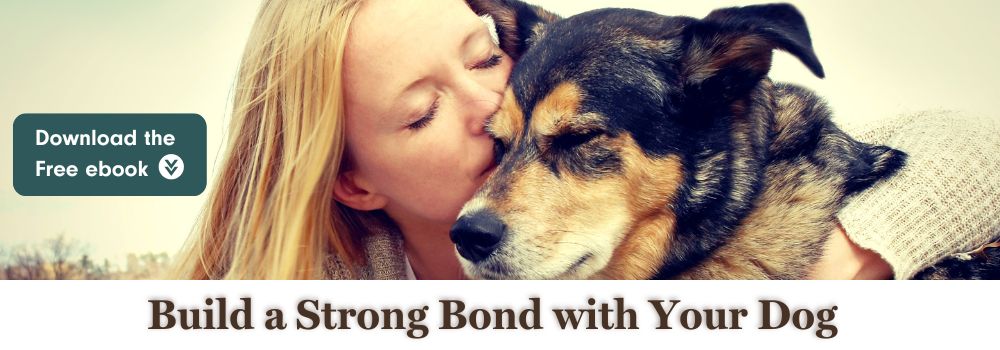



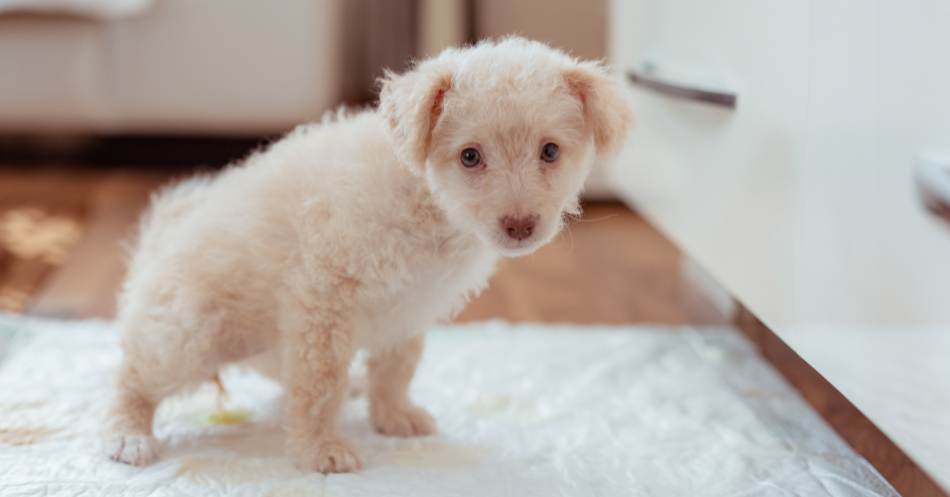
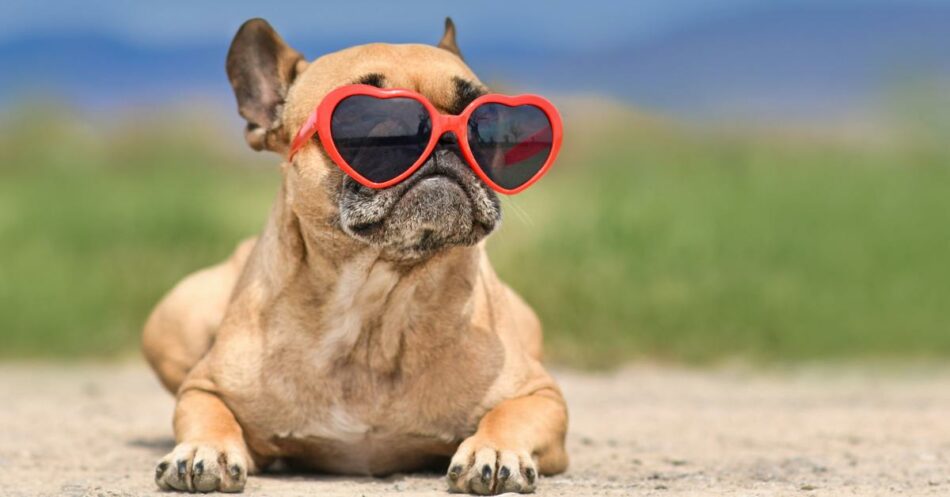
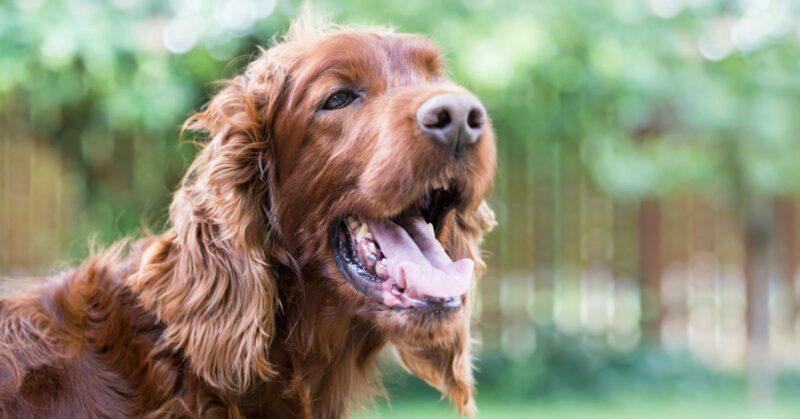
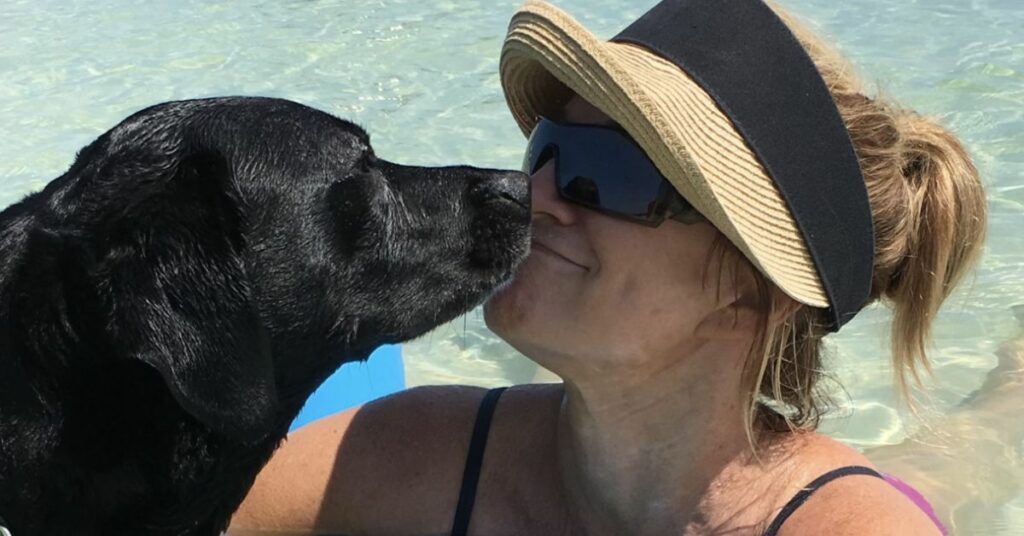
Thank you for this information. I’ve never read anything about this before. I hate to throw away his favorite toys that he plays with outside when they are filthy.